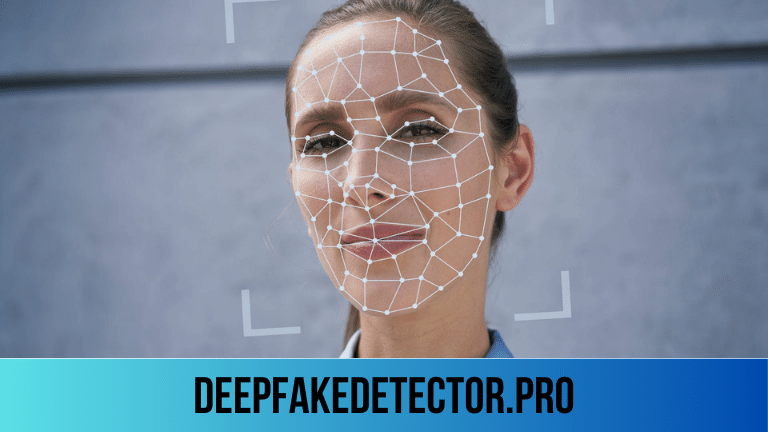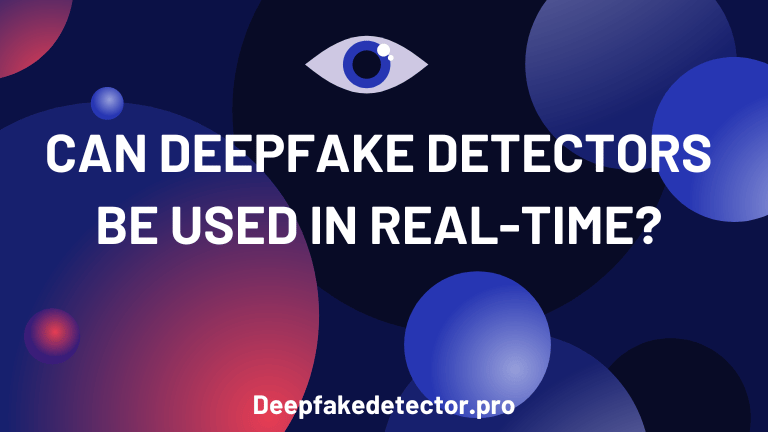Can DeepFake detectors be used in real-time? These sophisticated forgeries, which manipulate audio, images, and videos, pose a severe threat to individuals, businesses, and society as a whole. As deepfake technology continues to advance, the need for effective detection and mitigation strategies has become paramount.
One critical aspect of deepfake detection is the ability to operate in real-time, enabling organizations and individuals to identify and respond to deepfake threats promptly. Real-time detection is crucial in various scenarios, such as live events, social media monitoring, and cybersecurity applications, where timely action can prevent the spread of misinformation, protect reputations, and mitigate potential harm.
In this comprehensive guide, we’ll explore the concept of real-time deepfake detection, its importance, and the challenges associated with implementing such systems. We’ll also delve into the latest advancements in this field and provide insights into the potential future developments that could shape the way we combat deepfake threats.
Understanding Real-Time Deepfake Detection
Real-time deepfake detection refers to the ability to identify and flag deepfake content as it is being generated, transmitted, or consumed. This contrasts with traditional detection methods that operate on pre-recorded or stored media, where the analysis happens after the fact.
The Importance of Real-Time Detection
The importance of real-time deepfake detection cannot be overstated, as it offers several crucial advantages:
- Timely Intervention: Real-time detection enables immediate action to be taken, such as blocking or removing deepfake content before it can cause significant harm or spread widely.
- Mitigation of Rapid Spread: In today’s fast-paced digital world, deepfake content can propagate rapidly across various platforms and channels. Real-time detection can help contain the spread and minimize the potential impact of deepfake attacks.
- Protection of Live Events: Real-time detection is essential for live events, such as political debates, corporate presentations, or media broadcasts, where deepfake manipulation could have severe consequences if left unchecked.
- Enhanced Cybersecurity: Real-time deepfake detection can play a crucial role in cybersecurity applications, helping to identify and prevent deepfake-based attacks, such as voice spoofing, video impersonation, or social engineering attempts.
- Preservation of Trust: By implementing effective real-time detection mechanisms, organizations and individuals can maintain the integrity and trustworthiness of their digital content, safeguarding their reputations and credibility.
While the benefits of real-time deepfake detection are clear, achieving this capability presents significant technical and practical challenges that must be addressed.
Challenges in Real-Time Deepfake Detection
Implementing real-time deepfake detection systems is a complex endeavor that involves overcoming various obstacles, including:
- Computational Complexity: Real-time detection requires processing large volumes of data, such as video streams or audio feeds, in real-time, which can be computationally intensive and resource-demanding, especially for complex deepfake detection models.
- Low Latency Requirements: To be effective, real-time detection systems must operate with minimal latency, ensuring that deepfake content is identified and flagged before it can cause harm or spread significantly.
- Scalability and Performance: As the volume of digital media continues to grow, real-time detection systems must be scalable and capable of handling high throughput without compromising accuracy or performance.
- Evolving Deepfake Techniques: Deepfake technology is constantly evolving, with new techniques and methods emerging regularly. Real-time detection systems must be adaptable and capable of keeping pace with these advancements to remain effective.
- False Positive and False Negative Rates: Striking the right balance between false positive rates (incorrectly flagging authentic content as deepfakes) and false negative rates (failing to detect actual deepfakes) is crucial for maintaining trust and avoiding unnecessary disruptions.
- Integration and Deployment Challenges: Integrating real-time deepfake detection systems into existing digital infrastructure, workflows, and applications can be complex, requiring careful planning, testing, and deployment strategies.
Despite these challenges, significant progress has been made in the field of real-time deepfake detection, with researchers and organizations exploring various approaches and techniques to address these obstacles.
Approaches to Real-Time Deepfake Detection
Several approaches and methodologies have been developed or proposed to enable real-time deepfake detection, each with its strengths, limitations, and trade-offs.
Hardware Acceleration and Parallel Processing
One of the primary challenges in real-time deepfake detection is the computational complexity involved in processing large volumes of data in real-time. To address this, researchers and organizations have explored leveraging hardware acceleration and parallel processing techniques.
- Graphics Processing Units (GPUs): GPUs, with their highly parallel architecture and specialized hardware for matrix operations, can significantly accelerate the computational workload of deepfake detection models, enabling real-time performance.
- Field-Programmable Gate Arrays (FPGAs): FPGAs are reconfigurable hardware devices that can be programmed to perform specific computations efficiently, offering potential advantages in terms of power consumption and latency for real-time deepfake detection applications.
- Distributed Processing: Distributing the computational load across multiple processors or nodes can help achieve real-time performance by parallelizing the detection tasks and leveraging the combined processing power of multiple hardware resources.
- Edge Computing: Edge computing architectures, where detection models are deployed closer to the data source (e.g., on mobile devices or edge servers), can reduce latency and enable real-time detection by minimizing the need for data transmission over networks.
While hardware acceleration and parallel processing can significantly improve real-time performance, they also introduce challenges in terms of cost, power consumption, and the need for specialized hardware or infrastructure.
Model Optimization and Compression
Another approach to enabling real-time deepfake detection involves optimizing and compressing the underlying machine learning models to reduce their computational complexity and resource requirements.
- Model Pruning: Model pruning techniques identify and remove redundant or insignificant parameters from the neural network models, reducing their size and computational footprint without significantly impacting performance.
- Quantization and Binarization: Quantization and binarization methods convert the model’s parameters and computations from high-precision floating-point representations to lower-precision or binary formats, allowing for more efficient computations and reduced memory requirements.
- Knowledge Distillation: Knowledge distillation techniques transfer the knowledge from larger, more complex models to smaller, more efficient models, enabling real-time performance while maintaining reasonable accuracy.
- Architecture Search: Automated architecture search methods can explore and identify neural network architectures optimized for real-time deepfake detection, balancing accuracy and computational efficiency.
While model optimization and compression techniques can improve real-time performance, they often involve trade-offs between accuracy, generalization, and the ability to detect more sophisticated deepfakes.
Hybrid and Ensemble Approaches
Combining multiple detection techniques and modalities can improve the overall accuracy and robustness of real-time deepfake detection systems, leveraging the strengths of different approaches.
- Multi-Modal Fusion: Integrating visual, audio, and textual cues can enhance the detection capabilities, as deepfakes may exhibit inconsistencies or artifacts across different modalities.
- Ensemble Methods: Combining multiple detection models, each specializing in different aspects of deepfake detection (e.g., facial analysis, audio analysis, semantic analysis), can improve overall performance and reduce the impact of individual model weaknesses.
- Cascaded Detection: Implementing a cascaded detection approach, where computationally efficient models perform initial screening, and more complex models are employed for in-depth analysis of suspicious content, can balance real-time performance and accuracy.
- Adaptive and Incremental Learning: Incorporating adaptive and incremental learning techniques can enable real-time detection systems to continuously learn and adapt to new deepfake techniques, improving their robustness over time.
While hybrid and ensemble approaches can enhance real-time detection capabilities, they may introduce additional complexity, computational overhead, and the need for careful model integration and orchestration.
Streaming and Online Learning
Real-time deepfake detection often involves processing continuous streams of data, such as video feeds or audio broadcasts. Techniques that enable online learning and streaming-based detection can be particularly useful in such scenarios.
- Online Learning: Online learning algorithms can incrementally update and refine deepfake detection models as new data becomes available, enabling real-time adaptation and improving detection accuracy over time.
- Streaming Data Processing: Frameworks and libraries designed for streaming data processing, such as Apache Kafka, Apache Spark Streaming, or TensorFlow Data Validation.

FAQs
1. Can DeepFake detectors operate in real-time?
Yes, DeepFake detectors can operate in real-time, but their effectiveness depends on the computational power and the efficiency of the detection algorithms used. Real-time detection involves processing video or audio streams instantly to identify manipulations, which requires advanced algorithms and powerful hardware to ensure minimal latency.
2. What are the key requirements for implementing real-time DeepFake detection?
Implementing real-time DeepFake detection requires:
High-Performance Hardware: Powerful GPUs or specialized AI accelerators to handle the intensive computational load.
Efficient Algorithms: Optimized detection algorithms that can quickly analyze video and audio streams without significant delays.
Low Latency Network: A fast and stable network connection to ensure quick data transmission and processing.
Scalability: The ability to scale resources up or down based on the volume of data and the number of streams being analyzed simultaneously.
3. What challenges are associated with real-time DeepFake detection?
Challenges associated with real-time DeepFake detection include:
Computational Demand: Real-time processing requires significant computational resources, which can be expensive.
Algorithm Efficiency: Developing algorithms that are both accurate and fast enough to operate in real-time is complex.
False Positives/Negatives: Balancing speed and accuracy to minimize false positives and false negatives in real-time scenarios can be challenging.
Scalability Issues: Handling a large number of concurrent video streams or high-resolution videos without compromising performance.
4. What are some use cases for real-time DeepFake detection?
Use cases for real-time DeepFake detection include:
Live Broadcasting: Ensuring the authenticity of live broadcasts to prevent the dissemination of manipulated content.
Video Conferencing: Protecting the integrity of virtual meetings by detecting and flagging manipulated video feeds in real-time.
Social Media Live Streams: Monitoring live streams on social media platforms to quickly identify and address DeepFake content.
Surveillance Systems: Enhancing security by detecting and flagging DeepFakes in real-time video surveillance feeds.

